The Internet is keeping a massive secret. You can have a five-figure launch with nothing to sell. You don’t have time to waste on creating a course that no one buys. That strategy will kill your business like a poorly made shuffle. I’ve made over $20,000 in pre-sales alone and saved myself thousands of dollars by using Darwin’s theory of selling: only the profitable survive. Here’s the trick: Your ideas can be sold before they’ve even been created. That’s the beauty of pre-selling your online course. And I’m going to take you through how you can do it for your next or first course using webinars.
What is ‘pre-selling’?
Pre-selling your online course is the private launching of your course idea. The strategy? To make sure it’s profitable by getting hard cash in your hands before you make it.
Basics of marketing: want vs. need
First, you need to have an idea that your audience wants not needs. The crucial difference here is that most people create a course that they want to make, not always that others want to buy. Skip that hard learned lesson and make things that are easy to sell. How do you find that idea? Well, you ask questions and listen. Read between the lines of what people want. They want learn SEO? Why? Because it means free new buyers coming to their digital doorstep.
Take that data and turn it into your course idea: teach bloggers how to get more fans by making a few changes to how they use their WP blog.
For my $28,000-launch, I did three webinars educating, exciting, and pitching people who were interested in the topic my course solved (getting six months of clients).

In my first webinar, I had 91 people sign-up and 31 live attendees. The live attendees are the crucial part of this process, they’re the ones who are truly interested and are the best test for your course idea.
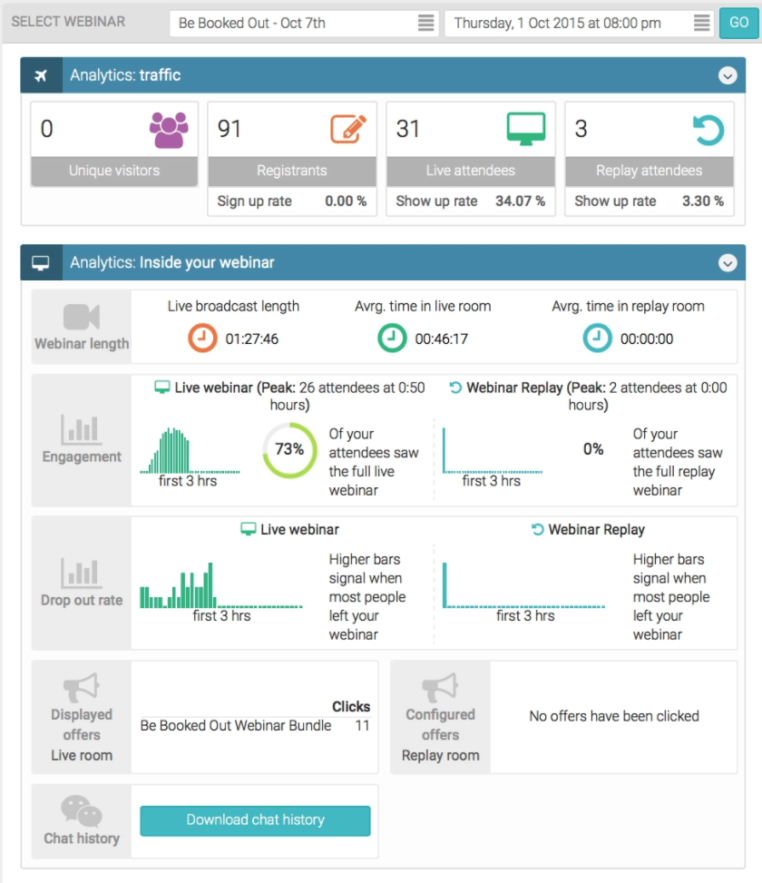
On this webinar, we made approximately $14,000 worth of sales! The majority paid with payment plans (which help decrease friction of buying the program), so it reflected differently in our payments dashboard.

Based on the first webinar alone, I knew my program idea was a solid money-maker. It had already made five figures!
Why? Pre-selling your online course is one of the only ways to tell if you have a money-maker in your head. You create the marketing (and a freebie), then sell it till you know it’s a winner or wannabe.
The equation to a profitable pre-sale:
(A course you’re pretty sure your ideal client wants) + (private funnels) / (webinars to sell it) = solid pre-sale.
If people want something they’ll put money down for it. No money means no desire but it also means don’t make it. At the end of the business day, what you want to create doesn’t always play a part in profit-making. This may mean you need to pivot ideas to move forward in your business. Between pre-selling your online course and delivering it, you could have a couple months maximum to get the sales in and start writing the content. That might mean that you’re wrapping up your launch and also writing content for your course.
For our launch, we started pre-selling October 7th and then started the program on November 8. The total sales generated by using pre-sales techniques and launching was approximately $28,000. Now, let’s get you pre-selling your online course.
7-step process to pre-selling your online course with webinars
1. Pick an income goal for your pre-sale
Take a look at your audience size and aim for about 2% of them buying your course. Multiply that number by your course price, how much would you make? Is that enough for you to create this course? If yes, then time to get selling it. If no, then it’s time to focus on list-building first.
For Evolve and Succeed, our numbers were: 919 subscribers x .02 = approximately 18 buyers. Our program is $997 so $997 x 18 = $17,946.

This was well worth my time to create the intense program. Per our first webinar, we hit 14 out of the 18 needed buyers. We were on our way.
2. Pick your pre-sale strategy
The fun part: selling. You can sell something without it ever having to be on your website, which means that if your course is not in line with your audience you can still make money from it. For example: You only have zebras on your list, but you want to start targeting lions. However, that would confuse (and terrify) your zebras, opt for a private pre-sale.
How do you sell privately? Pre-selling is perfect with webinar funnels, the supreme funnel of all funnels. Funnels are a set of emails that educate, excite, and inspire the reader to become a buyer. A webinar funnel uses a webinar to help fast-track the relationship between the reader and you. It burns down hesitation, opens up trust, and speeds up the buying process.
This is what the webinar funnel looks like:
Social media promos > opt-in/webinar sign-up > pre-webinar emails (educates them around your course’s main pain point) > live webinar (either solo or with another person)> post-webinar emails (pushing them to buy before the private sale closes) > send them to a waitlist if they don’t buy.
3. Create a pre-sales page + buy button
Your sales page is a key component of converting your prospects into buyers for a five-figure launch. Your pre-sales page has crucial key elements that get those course sales in. Luckily, Teachable’s course sales page (also called a course landing page) is exactly this and is beautifully designed so all you have to do is fill in text.
Here’s where you want to spend your time:
Hook, line, sinker: you need to start with a one or two sentence description of what your ideal client is struggling with.
“You spend Friday night crying into Merlot because your business isn’t getting enough clients in the door to make it profitable (and that’s why it’s a $5 bottle of Merlot).” This works perfectly as your course subtitle.
A clear description of life after they purchase your product or service. At Evolve and Succeed, we like using bullet points so it’s fast and easy for customers to read.

This fits in the course description section.
Testimonials: These should be short and reinforce the end goal you’re selling.
For example: If your promise is that buyers will become a zebra after taking your course, the testimonials should say “I’m a zebra now! All thanks to ZebraQueen!” Since you’re pre-selling your online course and you don’t have the full curriculum quite yet, you can pull testimonials from other services or products you’ve offered and tailor them as best as possible to this new course. Or drip out content to students slowly and get testimonials that way to use.
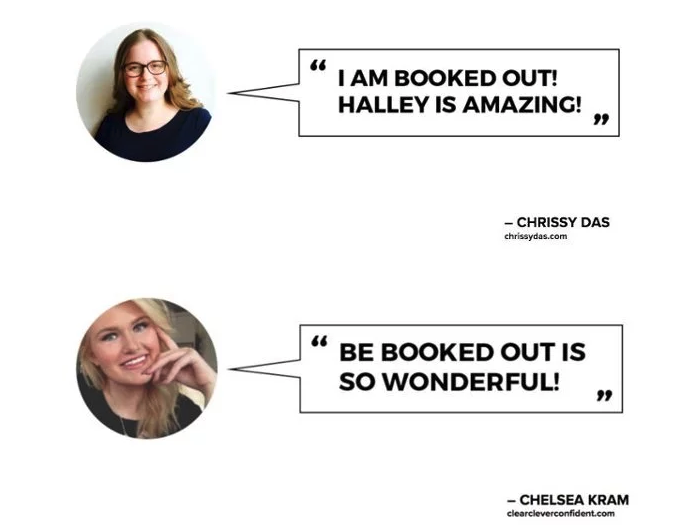
Mock-up versions of your product. People like to “see” the product before they purchase. Make sure to mock up any bonuses that they get as well, so that people who process information visually can get a sense of what they’re getting.
Bonuses can be: group calls, your other courses, additional PDFs, interviews with experts, physical products, discounts, etc.
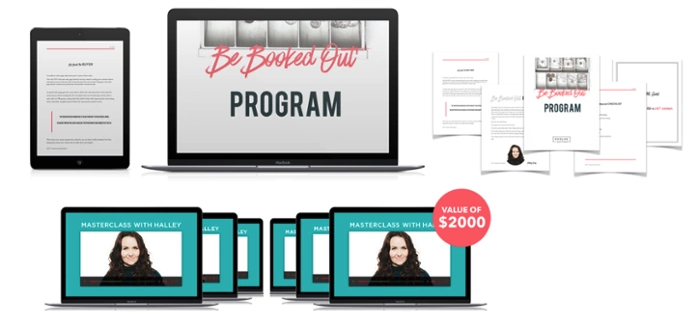
Payment section with the button. You need your “buy now” buttons and prices to be loud and proud. You can choose to have them pay in full or via payment plan, depending on the price of your course and what’s best with your individual audience. If you do tiered you want one button to be a different color, preferably the one that’s most popular.
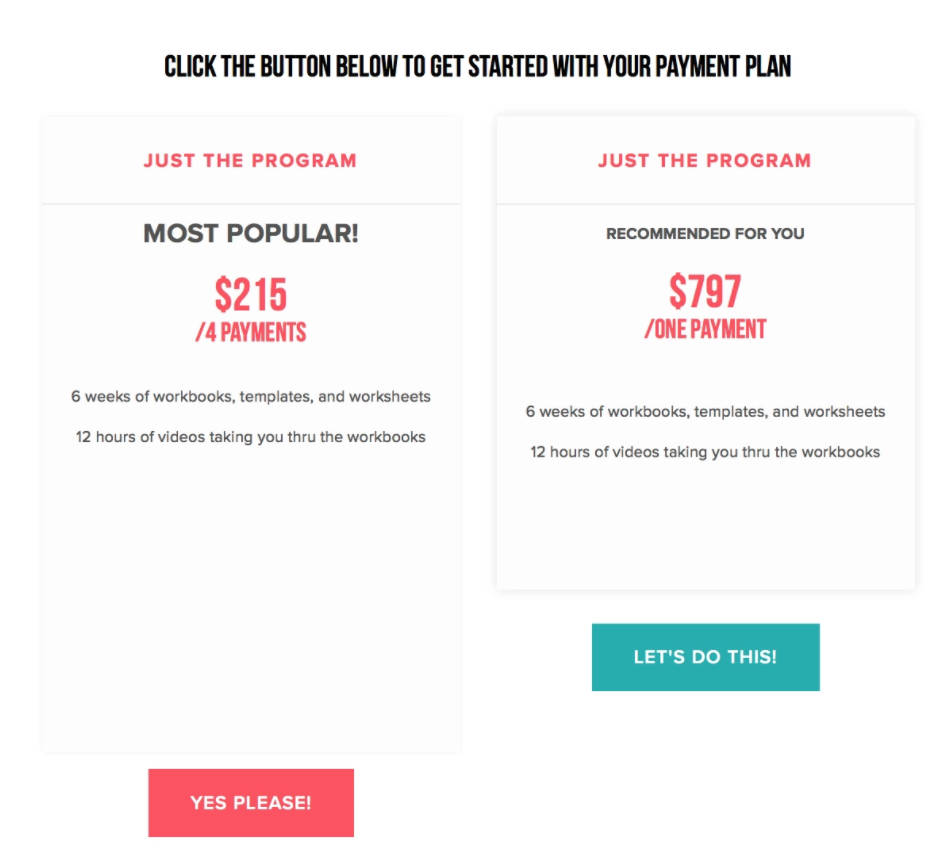
If you do the price by itself, you want the price above the button and by itself.

You want to have the buy buttons and pricing table on your sales page multiple times. Do so not just once but up to three or four times. This way you get your reader comfortable with the price and make it as easy as possible for them to buy.
4. Create an opt-in PDF or freebie content
An opt-in is basically a free product (think: PDF, video, worksheet, cartoon, etc.) you give someone in exchange for their email address. You give them valuable information delivered straight to their inbox, you get 24/7 access to their inbox. The beauty of this is that you use this to strategically pick out people who could be potential buyers for your course, making your life way easier when it comes to pre-selling.
The opt-in is a first taste of getting success with the process or method you’re going to teach them in your course. It’s easy. Actionable. Simple to understand. Once you’ve created your opt-in freebie, you need people to see it and get excited about it. Ways you can do that: social media, blog posts, webinars, ads, and asking friends to help promote.
The person who signs up to get your freebie is someone who is very likely to buy your course. That means you will send them a series of emails selling them your course after they get the freebie (it’s called a launch sequence, we’ll cover that more later).
6. Create a landing page for opt-in/freebie/webinar
A landing page is a stand-alone page that forces your reader to take action, specifically to get your freebie. You want to give them one clear, concise action forward: click this button and you get a PDF.
Because everyone has the attention span of a cracked out hamster these days, you need to give them only one thing to do on your landing page and that is click the button for your freebie. For my upcoming product, Five Figure Launch, our sign-up/landing page looks like this:
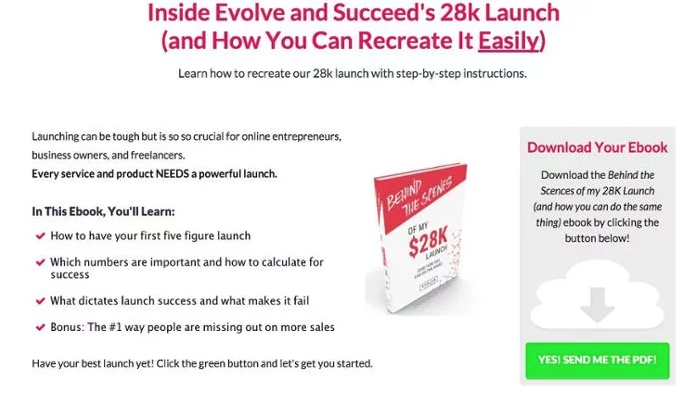
It gives anyone who lands on the page a clear understanding of what it is that they’re getting, and they only have one button to click that leads to submitting their e-mail address.
6. Private launch sequence
The private launch sequence (which we talked about in step four) is four to 10 emails that take the reader from sorta interested to not being able to sleep from wanting your course so bad.
For your best success of your launch sequence, you should have your webinar in the middle of this set of emails so it looks like:
Signs up for freebie > gets 1-2 emails educating them and inviting them to webinar > signs up to webinar > gets 2-4 emails talking about what the webinar will cover > goes to webinar (either buys on there but if they don’t) > gets 4-6 emails exciting them and urging them to buy.
The art of the webinar
The crux of this strategy of pre-selling your online course is the webinar. Unlike solely email-based sequences, you’re going to get a higher conversion rate (aka more people turning from strangers to buyers) because the webinar attendee can ask you questions, learn more about why they need your course, and get incredible value.
Webinars are an art form and when it comes to mastering them you totally want Mariah Coz on your side. The other half of it are your emails. You need to answer your potential buyer’s hesitations, overcome their obstacles, and paint a picture of the way their life could be if they bought your course.
Here’s what our pre and post-webinar sequence looked like:
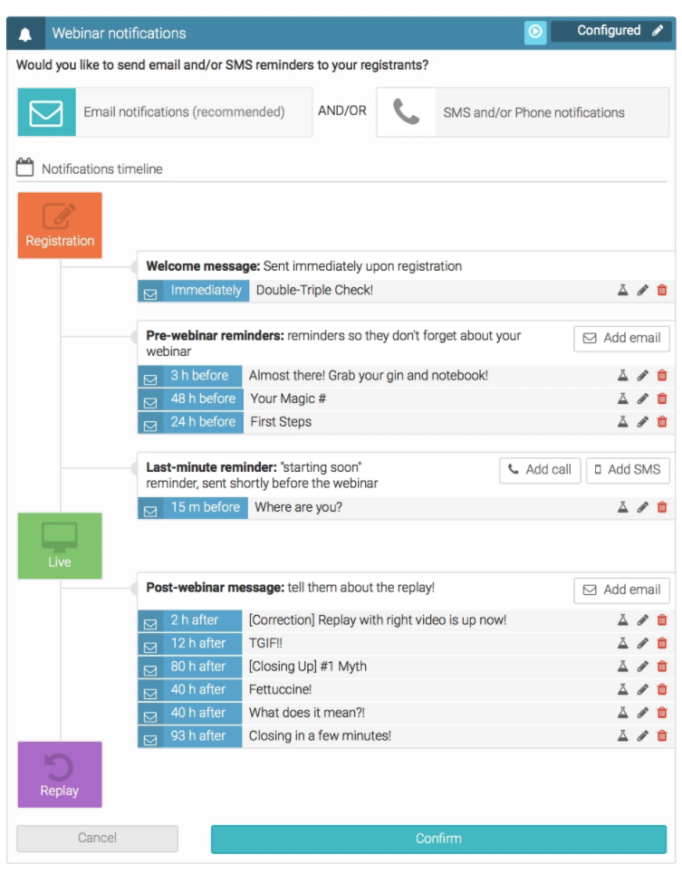
The pre-webinar emails should cover the following:
- What the steps are to get them to end goal you’re promising
- The biggest obstacle stopping them from moving by themselves
- The first step they can take towards doing it themselves
- What to expect in the webinar
The post-webinar emails should cover the following:
- Recap of the webinar highlights and link to watch the replay
- What success looks like and a case study (case study could be your story)
- A taste of what your course is like (opt-in/freebie/blog post you’ve done around this)
- Closing up and why they need to act now/recap of the value they’re getting
7. The webinar itself
A webinar is a live online presentation that you give and attendees can ask you questions, pop on with you to talk to you, and interact with you. They can be formal (with a slide deck), informal, or educational (you give them a workbook to work through), they can be done solo or with a friend.
There’s no limit to what kind of webinars you can put together for pre-selling your online course. The easiest ones are solo with a workbook I find. They allow you to interact naturally and students stay engaged. Plus, if people can’t make it live, you have the option of offering a replay (recorded video hosted on YouTube, Zoom,Vimeo or whatever you choose) so that you can accommodate time zones or allow them to re-watch later.
Insider secrets
A webinar is most effective when you give away about 15-20% of your secrets in the webinar. This means that even if someone doesn’t buy your product, they don’t feel like it was a waste of time. The best webinar is one that people get enough information from that they can put into place live and also inspires them to take action once they’re going solo.
How do you get people to your webinar? You create tweets, posts, scopes, emails to send out and invite people to sign up. Here’s an example of a tweet I did for my Be Booked Out webinar:
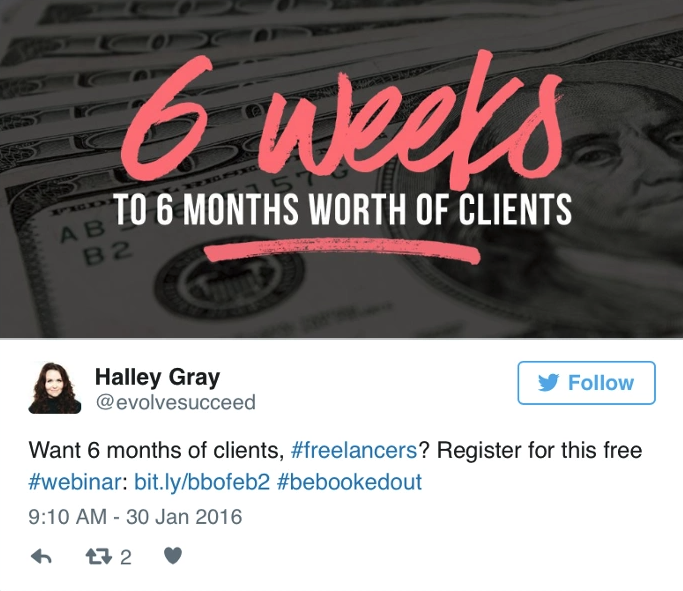
As you can see, the tweets are consistent with Be Booked Out’s branding and they have a large image so they stand out in your home feed. We schedule about 10 tweets, one Instagram post, and five Facebook updates per day when promoting a webinar.
The gear
The technical setup for webinars is pretty simple. All you need is:
- Computer with a webcam
- Gmail account
- A page to stick your Google Hangout onto (you can make one on your website and include a chat box, or you can use a service like WebinarJam which takes care of it for you)
Want to be fancy? Buy a separate microphone to make it sound cleaner and clearer. Otherwise make sure to have a set of earbuds with a microphone for good results.
The thing you need to spend the most time on is your “slide ride” or the Powerpoint/Keynote/Google slides that you’re going to use to present your information to people. Everything should tie in together visually so pick a couple of fonts and colors and stick with it through your workbooks, slides, and videos (if you end up making your course). You can buy pre-designed slide decks on places like Creative Market. I did that and found a couple of fonts I liked and updated it accordingly.
Here’s an example of the slides that I used for my Be Booked Out webinars.
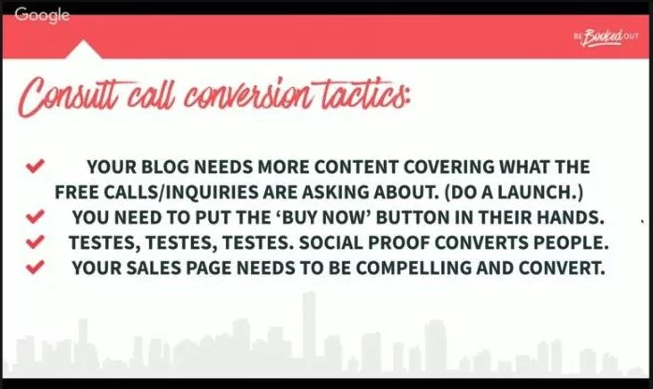
{{coursecurriculum-component="/blog-shortcodes/blog-popup"}}
Light a fire (aka time-sensitive selling)
Part of the burning need for buying is limited time. Think Black Friday. When you’re pre-selling your online course, a good way to spark action is by telling your audience the price will go up significantly if they don’t buy in 24-72 hours. That’s usually enough to be taken seriously, but if you want to go further, you could offer additional bonuses such as PDFs, training sessions, other courses that expire at the end of the email sequence.
Our incentive was: a bonus worth $2,000 (live group calls) and an early-bird price. The total value was $2,997 for a $699 price tag (and when we re-ran sign ups recently, we were able to increase the price to $997 because the first launch had gone so well).
You see, five figures of income secured and the course wasn’t even made. You can see the spikes in income from the pre-sales webinars and their post-webinar emails that sold the most spots below.
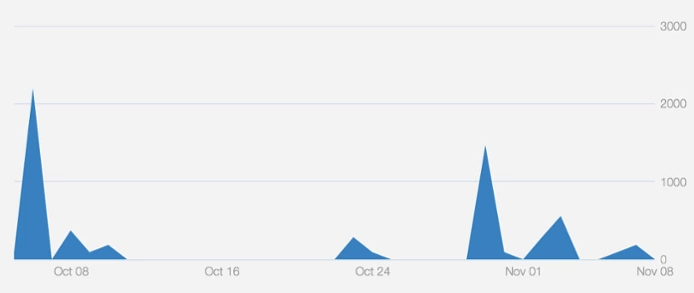
Don’t waste a minute on creating a course that doesn’t make bank before it exists. Pre-selling is where the profit is hiding and you can make it happen now. Don’t wait a minute more wondering ‘what if’ find out. By using this pre-selling method again and again you can generate thousands of dollars more and save yourself months (or years) of debt.
Next round is on you.
This is a guest post by Halley Gray, founder of Evolve + Succeed. A course creator herself, Halley shares how you can pre-sell your course with her 7-step method.
Join more than 150,000 creators who use Teachable to make a real impact and earn a real income.


